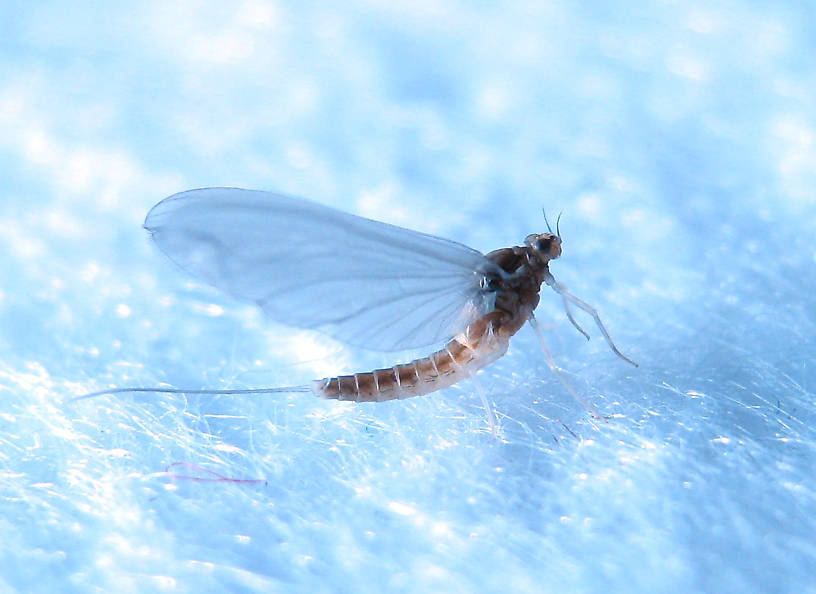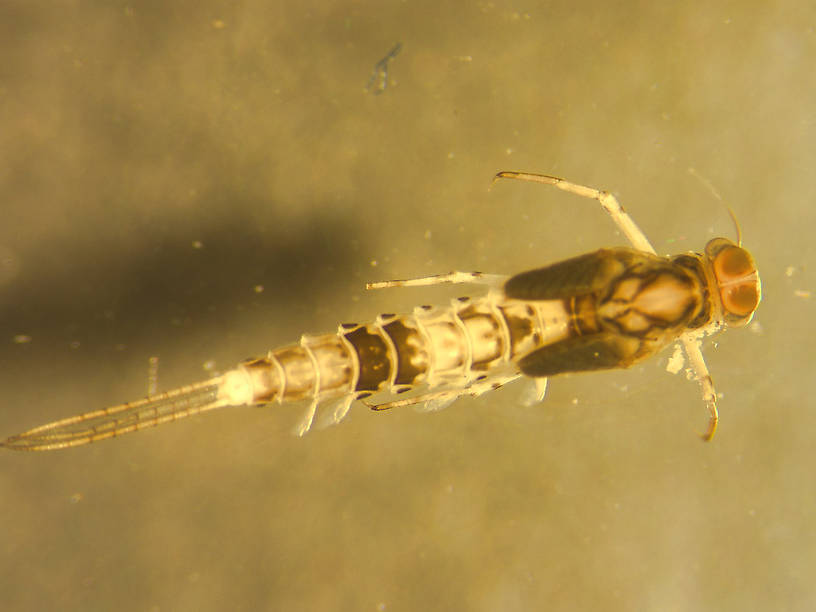
Salmonflies
Pteronarcys californica
The giant Salmonflies of the Western mountains are legendary for their proclivity to elicit consistent dry-fly action and ferocious strikes.
Featured on the forum

With a bit of help from the microscope, this specimen keys clearly and unsurprisingly to Hydropsyche.

Troutnut is a project started in 2003 by salmonid ecologist Jason "Troutnut" Neuswanger to help anglers and
fly tyers unabashedly embrace the entomological side of the sport. Learn more about Troutnut or
support the project for an enhanced experience here.
Mayfly Genus Anafroptilum (Tiny Sulphur Duns)
These species were previously in Centroptilum, a genus no longer represented in North America.
They are closely related to the important European "Spur Wings", a name given them due to the hook on the leading edge of their hind wings. These very small mayflies are usually reported in this country as inhabiting water too warm and/or stagnant for trout but this is not always the case. Significant numbers have been reported in many cold water environments throughout the West. These tiny sulphurish mayflies are easy to confuse with small Pale Morning Duns which is perhaps the reason for their under-reporting by anglers. Their having only two tails is the easiest to way to tell the difference.
From an angling perspective, a downside of many taxonomic advances is the loss of what was thought to be the ability to use easily identifiable morphological differences for determining between genera. This is especially problematic in sorting out baetids. The truth is the old rule used by anglers involving the hindwings (i.e., spurwing - prev. Centroptilum, no wing - prev. Pseudocloeon, the rest - Baetis) has been dubious for years. They can no longer be applied as more has been learned about new genera and species properly reassigned. It is now recognized that some species of Anafroptilum and Baetis lack hindwings altogether.
They are closely related to the important European "Spur Wings", a name given them due to the hook on the leading edge of their hind wings. These very small mayflies are usually reported in this country as inhabiting water too warm and/or stagnant for trout but this is not always the case. Significant numbers have been reported in many cold water environments throughout the West. These tiny sulphurish mayflies are easy to confuse with small Pale Morning Duns which is perhaps the reason for their under-reporting by anglers. Their having only two tails is the easiest to way to tell the difference.
From an angling perspective, a downside of many taxonomic advances is the loss of what was thought to be the ability to use easily identifiable morphological differences for determining between genera. This is especially problematic in sorting out baetids. The truth is the old rule used by anglers involving the hindwings (i.e., spurwing - prev. Centroptilum, no wing - prev. Pseudocloeon, the rest - Baetis) has been dubious for years. They can no longer be applied as more has been learned about new genera and species properly reassigned. It is now recognized that some species of Anafroptilum and Baetis lack hindwings altogether.
Genus Range
Hatching behavior
In cold water environments, Anafroptilum mayflies have been reported to emerge in typical baetid fashion. In warmwater, reporting suggests crawling out onto shore to hatch making the duns unimportant, though this fact is irrelevant as warm water precludes trout anyway.Spinner behavior
The duns molt into spinners the same day they emerge, and they fall spent right next to the bank after mating. But again this is warmwater behavior and does not translate to cold water environments where they are reported to fall to the surface in open currents.Specimens of the Mayfly Genus Anafroptilum
1 Female Dun

Approx. 5 mm. This is a very significant hatch. It is mostly seen at the height of Summer and I was very surprised to see it emerging this late in the season and in such numbers. When this one is emerging, the fish can become quite selective.
1 Nymph

A moderately rare mayfly perhaps because the nymphs are fragile that nymphs are usually damaged in collection making identification more difficult.
Discussions of Anafroptilum
Centroptilum?
Posted by Entoman on Jan 29, 2011
Last reply on Jan 29, 2011 by Entoman
These are the little creamy guys that hatch profusely on Fall River (CA), causing VERY selective feeding midday at the end of June/early July below the public access. Common name locally is Tiny PMD's which is a misnomer as these are NOT ephemerellids but rather baetids. Their sulfur coloration is what causes the confusion. Fall river runs well under 60 degrees during the Summer so I have my doubts that this (these) genus (genera) is (are) exclusive to warm water. Ernest Schwiebert identifies them when fishing the Paradise Valley spring creeks of Montana with Joe Brooks in one of his books. Makes one wonder if the fairly common reports of PMD's sized 20 and under on our Western spring creeks aren't really talking about this tiny critter.
In England, their olivaceous and larger cousins go by the name "Spur Wing" in honor of the rear projecting spike off the leading edge of the hind wing. They are reported as important hatches. This spur used to be the easiest identifying characteristic separating species of Centroptilum from others in the Baetidae family. Though the generic name has not been done away with, many species of possible importance to fishermen have been scattered among several genera (at least for now) and new ones added where this unique wing feature is not shared, thus making stream side identification beyond the familial virtually impossible. The only thing that can be known for sure is that species that fit the above description used to be called Centroptilum, so my comments on this hatch are listed here.
In England, their olivaceous and larger cousins go by the name "Spur Wing" in honor of the rear projecting spike off the leading edge of the hind wing. They are reported as important hatches. This spur used to be the easiest identifying characteristic separating species of Centroptilum from others in the Baetidae family. Though the generic name has not been done away with, many species of possible importance to fishermen have been scattered among several genera (at least for now) and new ones added where this unique wing feature is not shared, thus making stream side identification beyond the familial virtually impossible. The only thing that can be known for sure is that species that fit the above description used to be called Centroptilum, so my comments on this hatch are listed here.
Start a Discussion of Anafroptilum
References
- Arbona, Fred Jr. 1989. Mayflies, the Angler, and the Trout. Nick Lyons Books.
- Caucci, Al and Nastasi, Bob. 2004. Hatches II. The Lyons Press.
- Knopp, Malcolm and Robert Cormier. 1997. Mayflies: An Angler's Study of Trout Water Ephemeroptera . The Lyons Press.
- Leonard, Justin W. and Fannie A. Leonard. 1962. Mayflies of Michigan Trout Streams. Cranbrook Institute of Science.
Mayfly Genus Anafroptilum (Tiny Sulphur Duns)
Taxonomy
Species in Anafroptilum
Anafroptilum albumPale Watery Duns
1
3
Anafroptilum asperatum
0
0
Anafroptilum bifurcatum
0
0
Anafroptilum conturbatum
1
2
Anafroptilum minor
0
0
Anafroptilum semirufum
0
0
Species in Anafroptilum: Anafroptilum album, Anafroptilum asperatum, Anafroptilum bifurcatum, Anafroptilum conturbatum, Anafroptilum minor, Anafroptilum semirufum
2 species (Anafroptilum ozarkensum and Anafroptilum victoriae) aren't included.

